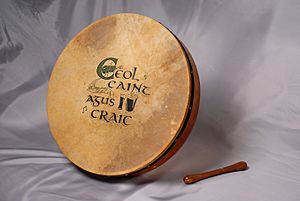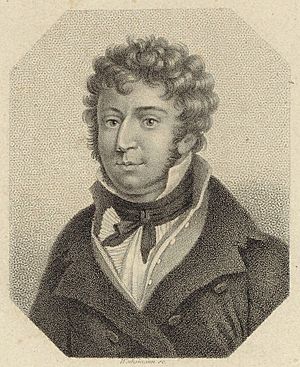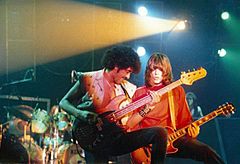Music of Ireland facts for kids

Irish music is music that comes from the island of Ireland. It includes many different styles, from very old traditional tunes to modern pop and rock.
The oldest type is called Irish traditional music. It's still very popular today, even with all the music from around the world. Even though many Irish people moved to other countries like Britain and the United States, Irish traditional music has kept its unique sound. It has even influenced other music styles, like country and roots music in the US. Sometimes, traditional Irish music is mixed with rock and roll or punk rock, and these new styles have become very successful!
Ireland also has a long history of classical music, going all the way back to the Middle Ages. Today, many composers write and perform new classical music. There are also many talented jazz musicians from Ireland, especially since the 1950s.
Contents
Music from Older Times
For a long time, up to the 1600s, rich families in Ireland supported harp musicians. This tradition slowly faded away in the 1700s. Turlough O'Carolan (1670–1738) is the most famous of these harp players. He wrote over 200 songs! Some of his music sounds a bit like classical music from his time, but it's now part of traditional Irish music and many folk musicians still play it.
In 1792, Edward Bunting wrote down some of the last known Irish harp tunes at the Belfast Harp Festival. Other important people who collected Irish music were Francis O'Neill and George Petrie.
Traditional Irish Music Today

Traditional Irish music has many kinds of songs, like drinking songs, ballads (story songs), and laments (sad songs). These can be sung without instruments or with many different ones.
Traditional dance music includes fast tunes like reels (in 4/4 time) and jigs (often in 6/8 time). Hornpipes are also popular. The polka dance came to Ireland in the early 1800s. Set dancing might have arrived even earlier.
The Irish fiddle has been played in Ireland for a very long time, since the 8th century! Bagpipes also have a long history in Ireland. Large Irish warpipes were used in battles as far back as the 1400s.
Around the early 1900s, traditional Irish music became popular again. Instruments like the button accordion and the concertina became common. Irish stepdance was performed at special gatherings called céilís, and at dance competitions. The Irish education system and patriotic groups helped keep Irish dancing alive. There was also an older way of singing called sean-nós ("in the old style"), which was mostly used for poetic songs in the Irish language.
From 1820 to 1920, over 4.4 million Irish people moved to the US. They created Irish communities in cities like Philadelphia, Chicago, Boston, and New York. Francis O'Neill made some of the first recordings of Irish music on old wax cylinders. Later, Irish musicians who became famous in the USA made commercial recordings. These recordings traveled around the world and helped make Irish music popular again back home. For example, American-based fiddlers like Michael Coleman helped spread Irish music in the 1920s and 1930s.
After a quiet period in the 1940s and 1950s, Irish folk music saw a big comeback in the 1960s. Bands like The Chieftains, The Clancy Brothers and Tommy Makem, The Dubliners, and The Irish Rovers helped make this happen. Seán Ó Riada was especially important. He promoted traditional Irish music on the radio, which led to the creation of The Chieftains. His work inspired other famous bands like Planxty, The Bothy Band, and Clannad in the 1970s. Later, groups like Altan and Dervish also became well-known.
Today, more and more people play Irish music, and many new bands appear every year, such as Téada and Lúnasa.
Classical Music in Ireland

Classical music has been played in Ireland since the early 1400s. Back then, there was a choir at Christ Church Cathedral in Dublin, and musicians were hired for special events in towns. In the 1700s, Dublin was a very important city for music. One famous event was the first performance of Handel's famous Messiah here.
Famous Classical Performers
Some famous classical musicians from Ireland include:
- Catherine Hayes (1818–1861): Ireland's first big international opera singer.
- John McCormack (1884–1945): One of the most celebrated singers of his time.
- Sir James Galway: A world-famous flute player.
- Barry Douglas: A pianist who won a gold medal at a major competition in 1986.
Choirs and Choral Music
Choral music (music sung by a group of singers) has been popular in Ireland for centuries, especially in big churches like Christ Church Cathedral.
The choir Anúna, started in 1987 by Michael McGlynn, helped make choral music more popular. They were part of the famous show Riverdance from 1994–1996. They even sang in the video game Diablo III in 2012!
The Chamber Choir Ireland is another important choir. Many local choirs also perform and compete at the yearly Cork International Choral Festival.
Opera in Ireland
Even though Ireland doesn't have a special opera house (the Cork Opera House is a theatre for many things), opera has been performed there since the 1600s. In the 1700s, Ireland was known for "ballad opera," which was a type of musical play.
Many Irish operas have been written over the years. Some even have their words in the Irish language. The Wexford Festival Opera is a big international festival that happens every year in October and November.
Popular Music in Ireland
Early Pop Stars
Popular music started to become big in Ireland in the late 1940s.
- Delia Murphy became famous for recording Irish folk songs.
- Bridie Gallagher became "Ireland's first international pop star" in 1956.
- Ruby Murray from Belfast had many hit songs in the UK in the 1950s.
- The Bachelors were a male singing group from Dublin who had hits all over the world.
- Val Doonican had many hits in the UK and even had his own TV show.
Irish Showbands
Showbands were very popular in Ireland, especially in the countryside, for about 20 years starting in the mid-1950s. A showband usually had six or seven musicians. They played in dance halls and performed all kinds of music: dance tunes, cover versions of pop hits (like rock and roll and country), and even some jazz. They were good at learning and playing the most popular songs of the day. Sometimes, they also played traditional Irish music.
Country and Irish Music
As American country music became popular, a new style called 'Country and Irish' developed in Ireland. It mixes American country music with Irish folk music. This often means traditional Irish songs are sung in a country style. It's very popular in rural parts of Ireland and among Irish people living in Britain.
Big Tom and The Mainliners were one of the first big bands in this style. Other famous artists include Philomena Begley and Margo, who is sometimes called the 'Queen of Country & Irish'. Today, Daniel O'Donnell is the most successful singer in this style, with fans in the UK, US, and Australia.
Mixing Music Styles (Fusion)
Traditional music also became part of Irish popular music later on. Bands like Clannad, Van Morrison, and Sinéad O'Connor used traditional sounds in their pop songs. Enya became famous worldwide by mixing traditional Celtic music with a New Age style.
The Afro-Celt Sound System became known in the 1990s for adding West African sounds and electronic dance beats to their music. Bands like Kíla mix traditional Irish music with rock and world music. One of the most famous fusion bands was Horslips, who combined Irish themes and music with heavy rock.
Riverdance was a very popular dance and music show that started at the Eurovision Song Contest 1994. It featured dancers like Michael Flatley and the choir Anúna. People loved it so much that a whole stage show was created from it!
Pop and Rock Music
The 1960s saw many important Irish rock bands and artists appear, such as Them, Van Morrison, Thin Lizzy, and Rory Gallagher.
In 1970, Dana put Ireland on the pop music map by winning the Eurovision Song Contest with her song "All Kinds of Everything". She became number one in the UK and across Europe, opening the door for many other Irish artists. Gilbert O'Sullivan also had many hit songs in the early 1970s.
When Punk rock started in the mid-1970s, groups like U2, The Boomtown Rats, The Undertones, and Stiff Little Fingers were formed. Later, in the 80s and 90s, Irish punk music changed into new styles of alternative rock, with bands like My Bloody Valentine and Ash.
In the 1990s, pop bands like The Corrs, B*Witched, Boyzone, Westlife, and The Cranberries became very popular. During this time, Ireland also contributed to a type of folk metal music called Celtic metal, with bands like Cruachan.
In recent years, Irish music in many different styles has been very successful around the world. The most successful styles have been rock, pop, and traditional fusion. Many artists have achieved success, including:
- U2
- Enya
- Westlife
- The Cranberries
- Van Morrison
- The Chieftains
- The Dubliners
- Kodaline
- Hozier
- The Script
- Snow Patrol
Top Selling Irish Music Acts
Here are some of the biggest selling Irish music acts of all time:
| Irish Act | Albums Sold | Music Style | Years Active |
|---|---|---|---|
| 1. U2 | Over 170 Million | Alternative Rock | 1976 – present |
| 2. Enya | Over 80 Million | Celtic/New-age | 1986 – present |
| 3. Westlife | Over 55 Million | Pop | 1998 – present |
| 4. The Cranberries | Over 50 Million | Rock | 1990–2003, 2009–2019 |
Most Standout Irish Acts
In 2010, a study asked people which five Irish musicians or bands they thought were the 'most standout'. U2 was at the top of the list, with 68% of the votes! Westlife, Van Morrison, Boyzone, and The Cranberries followed. This study also said that these top five acts had sold over 341 million albums by March 2010.
| Irish Act | Percentage of Votes | Music Style |
|---|---|---|
| 1. U2 | 68 | Alternative Rock |
| 2. Westlife | 10.5 | Pop |
| 3. Van Morrison | 10 | Soul |
| 4. Boyzone | 7.5 | Pop |
| 5. The Cranberries | 4 | Rock |
Images for kids
See also
 In Spanish: Música de Irlanda para niños
In Spanish: Música de Irlanda para niños




